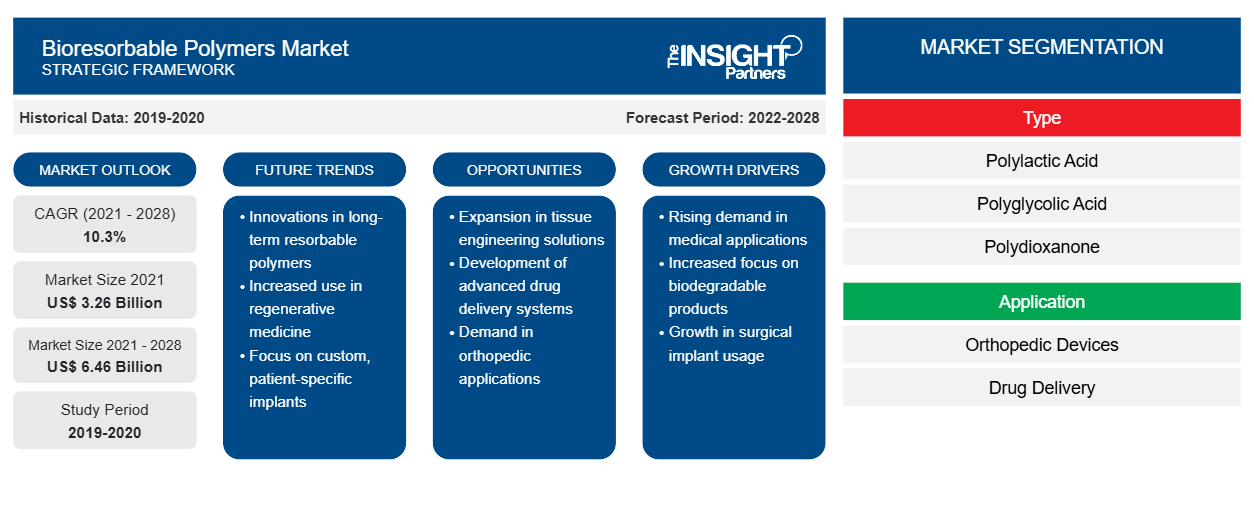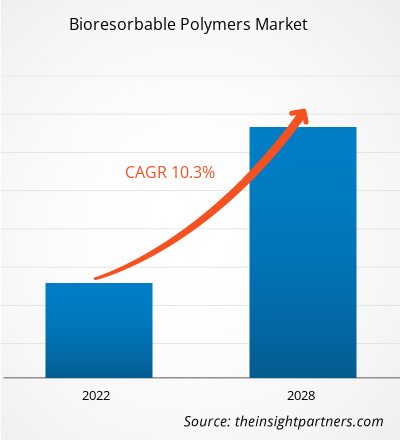2021 年生物可吸收聚合物市场价值为 32.6007 亿美元,预计到 2028 年将达到 64.6307 亿美元。预计 2021 年至 2028 年的复合年增长率为 10.3%。
生物可吸收聚合物植入物被广泛用于骨科手术中的骨折固定。骨科植入物,例如干涉螺钉、板、销钉、缝合锚、半月板修复植入物和简单骨折固定植入物,是前交叉韧带重建、肩部手术、半月板修复和骨折护理中最常用的可吸收植入物。当这些植入物被添加到体内时,它们会执行所需的动作,一旦完成,这些植入物就会被身体吸收。这些可吸收聚合物植入物包括缝合线、螺钉、支架、板、销钉和其他用于各种骨科子应用的植入物,例如创伤、髋关节、膝关节、脊柱、关节和其他损伤。这些植入物在植入后、愈合和支撑过程中会自然分解。因此,道路和现场事故的增加推动了对骨科植入物的需求,并随后推动了生物可吸收聚合物市场的增长。
定制此报告以满足您的需求
您可以免费定制任何报告,包括本报告的部分内容、国家级分析、Excel 数据包,以及为初创企业和大学提供优惠和折扣
- 获取此报告的关键市场趋势。这个免费样品将包括数据分析,从市场趋势到估计和预测。
COVID-19 疫情对生物可吸收聚合物市场的影响
持续的 COVID-19 大流行预计将对全球各个行业的增长造成相当大的干扰。然而,未来疫情的不确定性,尤其是在印度和其他一些亚洲国家,已经改变了多个工业部门的现状。亚太各国政府已采取可能的措施,宣布全国封锁,以限制病毒的传播,这直接影响了工业部门的增长。制造部门的关闭和供应链的中断阻碍了市场的发展。在印度,在 COVID 大流行期间,道路交通事故有所减少。据公路运输和公路部长称,道路交通事故减少了 26.48%。道路交通事故的减少导致组织工程的需求减少,这将减少对医疗植入物的需求,从而对生物可吸收聚合物市场产生负面影响。
市场洞察
3D 支架打印在组织工程中的应用日益广泛
生物可吸收聚合物越来越多地用于组织工程,利用 3D 支架打印技术创建类似器官的结构,这在医疗保健行业中获得了显著的关注。生物可吸收聚合物具有出色的细胞粘附特性,使其适用于组织工程应用,例如骨骼、肌腱、软骨、牙齿和脊柱再生。这些聚合物使用各种技术(例如静电纺丝和聚合物打印)制成支架,以创建促进组织发育的微结构和纳米材料。3D 支架打印可以产生具有可控特性的高度复杂设计,以实现高效、顺畅的组织工程。在预测期内,生物可吸收聚合物在 3D 支架打印中的应用预计将成为组织再生治疗和该市场的未来趋势。
类型洞察
根据类型,全球生物可吸收聚合物市场细分为聚乳酸 (PLA)、聚乙醇酸 (PGA)、聚二氧化酮、聚己内酯 (PCL) 等。2020 年,聚乙醇酸 (PGA) 部门在生物可吸收聚合物市场中占据最大收入份额。
应用程序洞察
根据应用,全球生物可吸收聚合物市场细分为骨科器械、药物输送等。骨科器械部门在 2020 年引领了生物可吸收聚合物市场。Bezwada
Biomedical, LLC;Evonik Industries AG;Foster Corporation;Ashland;Musashino Chemical Laboratory, Ltd.;惠州福佑医疗器械有限公司;Polysciences, Inc.;BMG;Poly-Med Incorporated;和 Reva Medical, LLC. 是全球主要的生物可吸收制造商。这些参与者正积极专注于产品创新,以开发更多适合人体且不会留下任何副作用的生物可吸收材料。
生物可吸收聚合物市场区域洞察
Insight Partners 的分析师已详细解释了预测期内影响生物可吸收聚合物市场的区域趋势和因素。本节还讨论了生物可吸收聚合物市场的各个部分和地理分布,包括北美、欧洲、亚太地区、中东和非洲以及南美和中美洲。

- 获取生物可吸收聚合物市场的区域特定数据
生物可吸收聚合物市场报告范围
| 报告属性 | 细节 |
|---|---|
| 2021 年市场规模 | 32.6亿美元 |
| 2028 年市场规模 | 64.6亿美元 |
| 全球复合年增长率(2021 - 2028) | 10.3% |
| 史料 | 2019-2020 |
| 预测期 | 2022-2028 |
| 涵盖的领域 | 按类型
|
| 覆盖地区和国家 | 北美
|
| 市场领导者和主要公司简介 |
|
生物可吸收聚合物市场参与者密度:了解其对业务动态的影响
生物可吸收聚合物市场正在快速增长,这得益于终端用户需求的不断增长,而这些需求又源于消费者偏好的不断变化、技术进步以及对产品优势的认识不断提高等因素。随着需求的增加,企业正在扩大其产品范围,进行创新以满足消费者的需求,并利用新兴趋势,从而进一步推动市场增长。
市场参与者密度是指在特定市场或行业内运营的企业或公司的分布情况。它表明在给定市场空间中,相对于其规模或总市场价值,有多少竞争对手(市场参与者)存在。
在生物可吸收聚合物市场运营的主要公司有:
- BMG集团
- 赢创工业集团
- 福斯特公司
- 阿什兰全球控股公司
- 保利美德公司
免责声明:上面列出的公司没有按照任何特定顺序排列。

- 了解生物可吸收聚合物市场的主要参与者概况
报告亮点
- 生物可吸收聚合物市场的渐进式行业趋势可帮助参与者制定有效的长期战略
- 发达市场和发展中市场采用的业务增长战略
- 2019 年至 2028 年生物可吸收聚合物市场的定量分析
- 生物可吸收聚合物的全球需求估计
- 波特的分析说明了行业内买家和供应商的有效性
- 了解竞争市场状况的最新发展
- 市场趋势和前景以及推动和抑制生物可吸收聚合物市场增长的因素
- 通过强调支撑商业利益的市场策略来协助决策过程,从而促进市场增长
- 不同节点的生物可吸收聚合物市场规模
- 市场的详细概述和细分,以及生物可吸收聚合物的行业动态
- 各地区生物可吸收聚合物市场规模及增长机遇
生物可吸收聚合物市场 – 按类型
- 聚乳酸(PLA)
- 聚乙醇酸 (PGA)
- 聚二氧化酮、聚己内酯 (PCL)
- 其他的
生物可吸收聚合物市场 – 按应用分类
- 矫形器械
- 药物输送
- 其他的
公司简介
- Bezwada 生物医学有限责任公司
- 赢创工业集团
- 福斯特公司
- 阿什兰
- 株式会社武藏野化学研究所
- 惠州市华阳医疗器械有限公司
- Polysciences 公司
- 骨密度仪
- 保利美德公司
- Reva Medical, LLC.
- 历史分析(2 年)、基准年、预测(7 年)及复合年增长率
- PEST 和 SWOT 分析
- 市场规模价值/数量 - 全球、区域、国家
- 行业和竞争格局
- Excel 数据集



Report Coverage
Revenue forecast, Company Analysis, Industry landscape, Growth factors, and Trends

Segment Covered
This text is related
to segments covered.

Regional Scope
North America, Europe, Asia Pacific, Middle East & Africa, South & Central America

Country Scope
This text is related
to country scope.
常见问题
Asia Pacific is estimated to register the fastest CAGR in the market over the forecast period. The presence of high-growth markets such as India, China, and Japan due to the rapid increase in the geriatric population; increase in the number of hospitals; the implementation of favorable government initiatives; rise in investments in the healthcare industry; surge in demand for cutting-edge surgery products; and the expansion of private-sector hospitals in the rural areas are driving the market in the region. The increase in the elderly population across the region has led to a higher prevalence of osteoarthritis and other conditions, resulting in injuries requiring orthopedic devices.
The polylactic Acid (PLA) segment registered the fastest CAGR in the global bioresorbable polymers market. PLA is extensively used to manufacture medical implant devices and parts such as screws, pins, rods, and plates due to its biodegradable properties. The advantage of using PLA-based small parts in medical devices enables it to naturally convert into lactic acid in the body at low concentrations and can be safely removed by the body’s excretory system. Also, PLA is widely used in tissue engineering for bone tissue replacement purposes which is one of the most recent utilities of this polymer in medical science.
Orthopedic devices segment has led the bioresorbable polymers market in 2020, in terms of revenue. The orthopedic devices segment of the bioresorbable polymers market accounts for one of the largest revenue shares of the market. The growth of the segment can be attributed to the increasing sub-application of trauma, hip, knee, spine and bone surgery globally. The growing instances of accidents, sports injury, and the ageing population globally is surging the need for various joint and bone surgeries. Bioresorbable polymers are extensively used to make sutures, screws, stents, pins, rods, and plates in implant devices. After adding these devices to the body, they perform the desired action, and once done, these implants get absorbed in the body by themselves. Further, these implants break down naturally after implantation, during the healing and supporting process.
The polyglycolic acid segment of the bioresorbable polymers market is expected to grow at a notable rate in the forecast years. Polyglycolic acid is commonly used in scaffolds for various tissue engineering applications such as bone, tendon, cartilage, tooth, and spinal regeneration. Also, polyglycolic acid is a well-known alternative for PLA in orthopedic applications.
The major players operating in the bioresorbable polymers market are Bezwada Biomedical, LLC; Evonik Industries AG; Foster Corporation; Ashland; Musashino Chemical Laboratory, Ltd.; Huizhou Foryou Medical Devices Co., Ltd.; Polysciences, Inc.; BMG; Poly-Med Incorporated; and Reva Medical, LLC.
In 2020, North America held the largest revenue share of the global bioresorbable polymers market. The US and Canada mainly lead the demand for bioresorbable polymers in North America. Factors such as the growing number of FDA approvals for medical devices and the increasing presence of well-developed healthcare systems are driving the bioresorbable polymer market in the region. Further, the increased presence of orthopedic impairment patients in the region has led to a rise in demand for bioresorbable polymers.
Trends and growth analysis reports related to Chemicals and Materials : READ MORE..
The List of Companies - Bioresorbable Polymers Market
- BMG Incorporated
- Evonik Industries AG
- Foster Corporation
- Ashland Global Holdings Inc.
- Poly-Med Incorporated
- REVA Medical, LLC
- Musashino Chemical Laboratory, Ltd
- Huizhou Foryou Medical Devices Co., Ltd.
- Polysciences Inc
- Bezwada Biomedical LLC
The Insight Partners performs research in 4 major stages: Data Collection & Secondary Research, Primary Research, Data Analysis and Data Triangulation & Final Review.
- Data Collection and Secondary Research:
As a market research and consulting firm operating from a decade, we have published and advised several client across the globe. First step for any study will start with an assessment of currently available data and insights from existing reports. Further, historical and current market information is collected from Investor Presentations, Annual Reports, SEC Filings, etc., and other information related to company’s performance and market positioning are gathered from Paid Databases (Factiva, Hoovers, and Reuters) and various other publications available in public domain.
Several associations trade associates, technical forums, institutes, societies and organization are accessed to gain technical as well as market related insights through their publications such as research papers, blogs and press releases related to the studies are referred to get cues about the market. Further, white papers, journals, magazines, and other news articles published in last 3 years are scrutinized and analyzed to understand the current market trends.
- Primary Research:
The primarily interview analysis comprise of data obtained from industry participants interview and answers to survey questions gathered by in-house primary team.
For primary research, interviews are conducted with industry experts/CEOs/Marketing Managers/VPs/Subject Matter Experts from both demand and supply side to get a 360-degree view of the market. The primary team conducts several interviews based on the complexity of the markets to understand the various market trends and dynamics which makes research more credible and precise.
A typical research interview fulfils the following functions:
- Provides first-hand information on the market size, market trends, growth trends, competitive landscape, and outlook
- Validates and strengthens in-house secondary research findings
- Develops the analysis team’s expertise and market understanding
Primary research involves email interactions and telephone interviews for each market, category, segment, and sub-segment across geographies. The participants who typically take part in such a process include, but are not limited to:
- Industry participants: VPs, business development managers, market intelligence managers and national sales managers
- Outside experts: Valuation experts, research analysts and key opinion leaders specializing in the electronics and semiconductor industry.
Below is the breakup of our primary respondents by company, designation, and region:

Once we receive the confirmation from primary research sources or primary respondents, we finalize the base year market estimation and forecast the data as per the macroeconomic and microeconomic factors assessed during data collection.
- Data Analysis:
Once data is validated through both secondary as well as primary respondents, we finalize the market estimations by hypothesis formulation and factor analysis at regional and country level.
- Macro-Economic Factor Analysis:
We analyse macroeconomic indicators such the gross domestic product (GDP), increase in the demand for goods and services across industries, technological advancement, regional economic growth, governmental policies, the influence of COVID-19, PEST analysis, and other aspects. This analysis aids in setting benchmarks for various nations/regions and approximating market splits. Additionally, the general trend of the aforementioned components aid in determining the market's development possibilities.
- Country Level Data:
Various factors that are especially aligned to the country are taken into account to determine the market size for a certain area and country, including the presence of vendors, such as headquarters and offices, the country's GDP, demand patterns, and industry growth. To comprehend the market dynamics for the nation, a number of growth variables, inhibitors, application areas, and current market trends are researched. The aforementioned elements aid in determining the country's overall market's growth potential.
- Company Profile:
The “Table of Contents” is formulated by listing and analyzing more than 25 - 30 companies operating in the market ecosystem across geographies. However, we profile only 10 companies as a standard practice in our syndicate reports. These 10 companies comprise leading, emerging, and regional players. Nonetheless, our analysis is not restricted to the 10 listed companies, we also analyze other companies present in the market to develop a holistic view and understand the prevailing trends. The “Company Profiles” section in the report covers key facts, business description, products & services, financial information, SWOT analysis, and key developments. The financial information presented is extracted from the annual reports and official documents of the publicly listed companies. Upon collecting the information for the sections of respective companies, we verify them via various primary sources and then compile the data in respective company profiles. The company level information helps us in deriving the base number as well as in forecasting the market size.
- Developing Base Number:
Aggregation of sales statistics (2020-2022) and macro-economic factor, and other secondary and primary research insights are utilized to arrive at base number and related market shares for 2022. The data gaps are identified in this step and relevant market data is analyzed, collected from paid primary interviews or databases. On finalizing the base year market size, forecasts are developed on the basis of macro-economic, industry and market growth factors and company level analysis.
- Data Triangulation and Final Review:
The market findings and base year market size calculations are validated from supply as well as demand side. Demand side validations are based on macro-economic factor analysis and benchmarks for respective regions and countries. In case of supply side validations, revenues of major companies are estimated (in case not available) based on industry benchmark, approximate number of employees, product portfolio, and primary interviews revenues are gathered. Further revenue from target product/service segment is assessed to avoid overshooting of market statistics. In case of heavy deviations between supply and demand side values, all thes steps are repeated to achieve synchronization.
We follow an iterative model, wherein we share our research findings with Subject Matter Experts (SME’s) and Key Opinion Leaders (KOLs) until consensus view of the market is not formulated – this model negates any drastic deviation in the opinions of experts. Only validated and universally acceptable research findings are quoted in our reports.
We have important check points that we use to validate our research findings – which we call – data triangulation, where we validate the information, we generate from secondary sources with primary interviews and then we re-validate with our internal data bases and Subject matter experts. This comprehensive model enables us to deliver high quality, reliable data in shortest possible time.


 获取此报告的免费样本
获取此报告的免费样本